Champagne & Food Pairing Notebook: To the Test at Restaurant ‘Bunny Bunny’ in Detroit’s Eastern Market
Notebook
A’Boudt Town
A chronicle of the early history of The New Yorker magazine, Ben Yagoda’s ‘About Town’ recounts a universe inhabited by writerly types perennially sipping something between bouts of literary greatness.
Nabokov favored tawny port while the out-of-print humorist Peter De Vries preferred Piesporter, Joseph Rosenblum notes in his review of the book.
I’m a wine merchant, not a novelist. But the stories locked in the bottles lining the walls of my shop can be just as layered and demanding as the most assertive prose, each one telling of a specific time in history and place in the world.
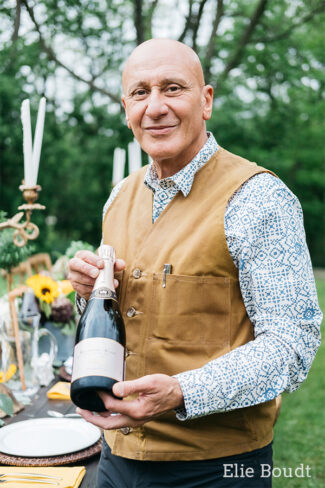 At Elie Wine Co., we know most of our producers personally, so the stories here go deeper — often to family, tradition, excellence, and craft.
At Elie Wine Co., we know most of our producers personally, so the stories here go deeper — often to family, tradition, excellence, and craft.
And then there is the story of Champagne, which, both despite and because of its outsized reputation, is today one of the most underappreciated, misunderstood and unfairly pigeonholed regions and classes of wine in the world.
Perhaps because of its long affiliation with European aristocracy, Champagne has been unfairly caged by notions of luxury and opulence that, frankly, don’t apply to many of the humble men and women making the most riveting expressions of it today.
So, let’s first dispel any notions that Champagne must be a luxury item only for special occasions. While it does pair well with celebratory caviar, Champagne can also be the perfect foil for spicy Indian carryout or crispy fried chicken.
In A’Boudt Town, you will find me, Elie Boudt, deepening our understanding of Champagne while having fun with a beverage that immediately elevates any moment.
Future installments of this feature will take you to a diverse range of restaurants around metro Detroit, my home for 40 years, while introducing you to today’s most exciting Champagne producers and their wines.
In the process, we’ll challenge preconceived notions of what Champagne is and can be, and introduce the idea that — despite Champagne’s long history — the best may yet still be ahead.
Champagne & Food Pairing
Restaurant ‘Bunny Bunny’ in Detroit’s Eastern Market
For our first installment of A’Boudt Town, we aimed our sights far beyond what might be thought of as traditional Champagne food — no oysters, no caviar, and no special occasion to celebrate.
It was an otherwise uneventful Wednesday until our casual dinner at Bunny Bunny in Eastern Market, where chefs Jennifer Jackson and Justin Tootla were previewing a directional shift in their cooking, moving from the by-the-book regional Chinese cuisine they launched with a more personal approach that highlighted Justin’s family roots in northern India in particular.
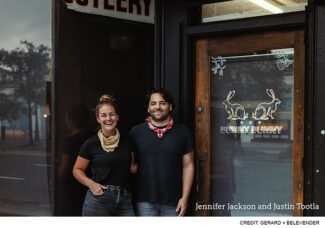
For our first installment of A’Boudt Town, we aimed our sights far beyond what might be thought of as traditional Champagne food — no oysters, no caviar, and no special occasion to celebrate.
It was an otherwise uneventful Wednesday until our casual dinner at Bunny Bunny in Eastern Market, where chefs Jennifer Jackson and Justin Tootla were previewing a directional shift in their cooking, moving from the by-the-book regional Chinese cuisine they launched with a more personal approach that highlighted Justin’s family roots in northern India in particular.
Pierre Paillard produces about 7,500 cases a year of Bouzy Champagne and is not to be confused with the much larger producer, Bruno Paillard, which blends across villages in Reims.
We sampled three cuvées from Paillard: the non-vintage, Pinot Noir-dominated ‘Les Parcelles XVI’; the 2014 ‘Les Mottelettes’ Blanc de Blancs, made from single-vineyard old-vine Chardonnay; and the ‘Les Terres Rose XVII,’ a unique Champagne rosé made by adding a small amount of still red pinot noir to the base wine.
At Paillard, Roman numerals on non-vintage bottles indicate the year of the base wine, typically 80% of the blend, lending rare insight into even its blended wines.
All of the wines spend extended time sur lie, and dosage for all is in the extra-brut range.
We opened the ‘Les Parcelles’ first. A 70/30 blend of Pinot Noir and Chardonnay, this was the broadest-shouldered of the bunch. Citrus-centric and showing dried fruit before its creamy, lingering finish.
‘Les Parcelles’ saline minerality paired exceptionally well with a dish of chilled clams dressed with uni-like globs of vadouvan yogurt and slivers of fresh asparagus lightly marinated in chili oil. Asparagus can be problematic to pair, but the wine overcame this by accentuating the brininess of the dish instead. A welcome start on both fronts.
Generally, ‘Les Parcelles’ aromatized the herbaceous green notes of the cuisine, especially in a vibrant cold chicken dish inspired by Naga-style pork, which includes hunks of fermented bamboo mixed with ginger, mint, and chilis.
‘Les Mottelettes’ was much softer on the palate, as expected of a Blanc de Blancs, but showed much more umami-like characteristics and less citrus than ‘Les Parcelles.’ Incidentally, 2014 was a problematic vintage in Bouzy, with a cold and rainy summer, but that didn’t seem to affect the Chardonnay.
While ‘Les Parcelles’ aromatized the greens in the food, ‘Les Motelletes’ did not, acting almost as a palate volume dial. Its oxidative and autolytic characters allowed the spices to be heard, but the acid kept them in check, even when paired against a dry chili chicken dish studded with tongue-numbing Szechuan peppercorns. Many wines would not hold up, but somehow the pairing here only magnified the fruit characteristics of the wine.
The Rosé was vinous, perfumed and creamy, exhibiting a gentle moelleux. It played very well with one of the standout dishes of the night, a wok-fried tandoori chicken, smokey and slathered in tamarind sauce that recalled Southern American barbecue. The perceived sweetness in the wine brought out the meaty flavors of the fall-apart chicken and stood up to the sweetness in the dish itself.
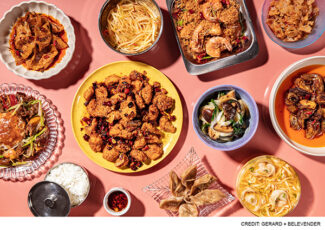
Somehow, none of the food overpowered any of the wines. And though each served a different purpose, the 2014 Blanc de Blancs was the most dexterous of the bunch despite its more narrow focus. And now we see why Paillard remains committed to Chardonnay in Bouzy.
Still, each of the wines had a texture that was present, a beautiful dance between light and loud. Inherently, when you drink wine with bubbles, it just seems to be light. But there’s an interplay between light and loud that’s brought out by pairing Champagne with the spicy food and the dance here was quite enjoyable. Champagne is high in acid, which tends to cut through fat, salt, and spices, but here it somehow also made the food more vibrant and assertive.
One of the most beautiful aspects of any Champagne is the fact that its very presence elevates any moment, its bubbles lifting even a weekday dinner to its own cause for celebration.
And we certainly celebrated at Bunny Bunny. Even if it was a Wednesday.
Bunny Bunny – 1454 Gratiot Ave, Detroit, Michigan 48207 USA – (313) 974 6122
Champagne, Considered
Champagne is undergoing an attitude renaissance, and much of the evolution is driven by consumers. Throughout the world of still wines, the focus is shifting toward improved agriculture, with organic and biodynamics creating sustainable terroir conditions. Champagne is doing likewise of course, along with promoting grower estates, small houses, reduced dosages and single-vineyard bottlings. But Champagne has long lived inside a rarefied world where much of its mystique was based on perception; its special-occasion aura, if consumers knew about much about the estates themselves, it was generally their ‘house style’—largely the result of winemaking technique. Bollinger spends more time on lees, for example, making it more yeasty in the mouth while Pol Roger allows fruit and floral notes to take the diva role by limiting lees contact. Reductive Champagnes like Salon do not undergo malolactic fermentation whereas oxidative wines, mostly Pinot Noir-based, are often oak aged, and taste rounder and sweeter.
What often gets lost amid the raised flutes and celebratory glitter is that Champagne is, first and foremost, wine, and as such, is highly expressive of its vineyard origins—when the winemakers allow this uniqueness to shine through. House styles have traditionally focused less on a reflective sense of the land on which the grapes were grown, and this is something that contemporary Champagne houses are beginning to explore, exploit, and advertise.
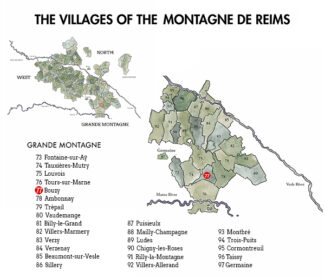
Each of the wines in this package is ‘climat’ specific, meaning that the grapes come from vineyard parcels as designated by the labels. It is a single Champagne house producing a variety of sparkling wines that emphasize—above all—a sense of place. These wines are expressive of various lieux-dits in and around the village of Bouzy; they are all classified as Grand Cru. Bouzy is one of the only 17 Grands Crus of the 320 villages, which make up Champagne’s seven sub-regions. (See Map Here)
Champagne Pierre Paillard
Bouzy – Grand Cru
(Grande Montagne in The Montagne de Reims)
Paillard is a familiar name to fans of Champagne; Maison Bruno Paillard, the Reims-based producer, was founded in 1981 by Bruno Paillard and financed by the sale of Bruno’s Mark II Jaguar. The Bouzy branch of the family (they are cousins) have been at it a bit longer; Antoine Paillard first bought Bouzy vineyards in 1768. Antoine and Quentin Paillard represent the eighth generation in the family and the fourth generation to produce and bottle Champagne under the family name.
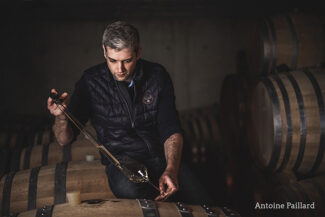
Bouzy is renowned for producing some of the finest Pinot Noir in Champagne, due in the main to its situation on the south-facing side of the Montagne de Reims, ideal for the difficult to ripen Pinot Noir grape. Nevertheless, unlike most other growers in the appellation, the 25 Paillard acres are planted with 40% Chardonnay, giving their wines both finesse and elegance.
Interestingly, the Paillards exclusively cultivate their own selection of Pinot Noir and Chardonnay, without a single clone on the estate, a diverse Selection Massale. Each plot is harvested and vinified separately in stainless steel vats and fermentation is carried out at lower temperatures to retain the aromatics. Each spring, a long process of tasting and blending is undertaken by Antoine and Quentin; the still wine is tasted, marked and discussed until there is consensus on the profile of the vintage. Blind tastings continue until the creation of each final cuvée. In June they are put into bottle for the second fermentation and cellared for a minimum of 3 years and as much as 10 years before being disgorged.
Champagne Pierre Paillard produces five cuvées. Two are non-vintage: Brut Grand Cru, generally a blend of two years and containing 60% Pinot Noir and 40% Chardonnay, and Brut Rosé, with a base of 70% Chardonnay, 23% Pinot Noir, and 7% Bouzy Rouge Pinot Noir. There are three vintage wines—a Blanc de Noirs from a single 0.8-acre parcel called ‘Les Maillerettes’ (planted in 1970), a Blanc de Blancs from a 1.5-acre parcel called ‘Les Mottelettes’ (planted in 1961) and a vintage wine that is only made in the best years and aged for seven to ten years before being disgorged.
A Note on Vintages:
2008: An icy December the previous year led to an even colder January. Below-average temperatures continued into the spring, and it did not warm up until May. But flowering was not affected and some summer outbreaks of oidium and mildew were quickly handled. August was cool, but by the mid-September harvest, the grapes were in perfect health. The vintage proved spectacular and is widely considered to be one of the top two vintages of this century so far.
2014: Dry conditions early got the growing season off to a healthy start, with a successful budburst and flowering were successful. The summer was not so kind, being cool and wet, with only the latter half of August eventually drying out. Although the rain was enough to make rot a concern, cooling breezes fortunately kept it at bay, and a benign September brought warm, dry conditions for ripening the grapes and effectively saving the harvest.
2016: 2016 was a difficult growing season, with early frosts and heavy rains between May and July putting much of the crop at risk. Conditions improved by August, but blistering heat further reduced yields. The grapes that remained were healthy, and overall, the quality was good, with wines displaying rich fruit and some nice acidity.
nv Champagne Pierre Paillard ‘Les Parcelles XVI’ Grand Cru – Bouzy Extra Brut ($57)
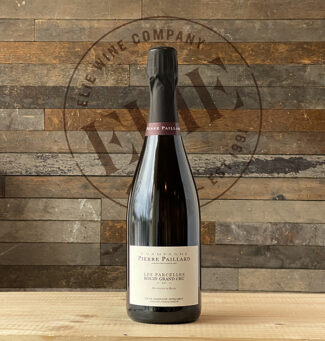 (Disgorgement: March 2021, Base Wine: 2016) Produced from 22 individually vinified parcels with their own vineyards, entirely in Bouzy, ‘Les Parcelles’ is a blend of 70% Pinot Noir and 30% Chardonnay, with 30% reserve wine. It is dosed at 1 gram per liter and has spent a full four years sur-lie prior to disgorgement. It’s an accurate portrait of Bouzy terroir with apple and salty stone-fruit notes. Citrus appears towards the finish, accented with herbs and chalk.
(Disgorgement: March 2021, Base Wine: 2016) Produced from 22 individually vinified parcels with their own vineyards, entirely in Bouzy, ‘Les Parcelles’ is a blend of 70% Pinot Noir and 30% Chardonnay, with 30% reserve wine. It is dosed at 1 gram per liter and has spent a full four years sur-lie prior to disgorgement. It’s an accurate portrait of Bouzy terroir with apple and salty stone-fruit notes. Citrus appears towards the finish, accented with herbs and chalk.
nv Champagne Pierre Paillard ‘Les Terres Roses XVII’ Grand Cru – Bouzy Rosé Extra Brut ($73)
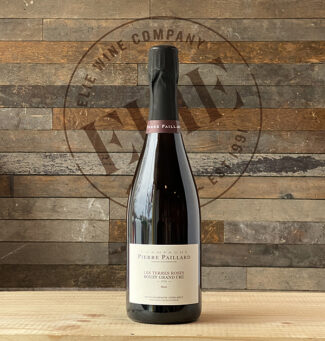 Disgorgement: April 2020, Base Wine: 2017) The delicacy and refinement inherent in this Rosé is the result of the cuvée, 64% Chardonnay, and 36% Pinot Noir vinified white. It’s dosed at 2 grams per liter but is quite dry, making it an ideal companion to shellfish, especially lobster. The nose is yeasty, like freshly baked brioche, and the palate displays a leesy undercurrent along with blood-orange and tangerine flavors before a clean and acidic finish.
Disgorgement: April 2020, Base Wine: 2017) The delicacy and refinement inherent in this Rosé is the result of the cuvée, 64% Chardonnay, and 36% Pinot Noir vinified white. It’s dosed at 2 grams per liter but is quite dry, making it an ideal companion to shellfish, especially lobster. The nose is yeasty, like freshly baked brioche, and the palate displays a leesy undercurrent along with blood-orange and tangerine flavors before a clean and acidic finish.
2014 Champagne Pierre Paillard ‘Les Mottelettes’ Grand Cru – Bouzy, Blanc de Blancs Extra Brut ($93)
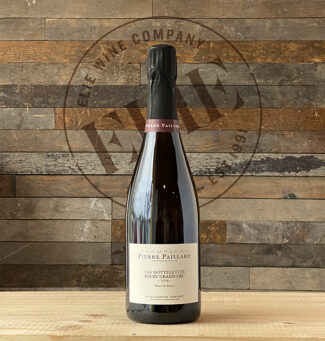 (Disgorgement: February 2019) From a miniscule plot of Chardonnay planted in 1961 in the lower part of Bouzy, where the pure chalk lays only twenty inches beneath the topsoil, the wine is pale golden in color with salted almond, apricot, pastry and fresh ginger notes beneath a delicate mousse. Dosage is at 1 gram/liter, with about 3000 bottles produced.
(Disgorgement: February 2019) From a miniscule plot of Chardonnay planted in 1961 in the lower part of Bouzy, where the pure chalk lays only twenty inches beneath the topsoil, the wine is pale golden in color with salted almond, apricot, pastry and fresh ginger notes beneath a delicate mousse. Dosage is at 1 gram/liter, with about 3000 bottles produced.
2016 Champagne Pierre Paillard ‘Les Maillerettes’ Grand Cru Bouzy, Blanc de Noirs Extra Brut ($91)
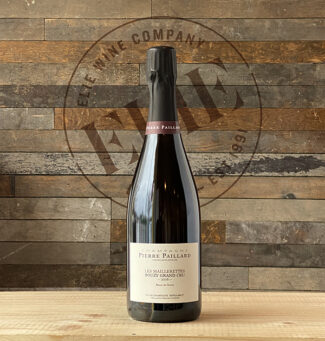 (Disgorgement: February 2021) ‘Les Maillerettes’ is a single half-acre of old vine Pinot Noir planted in 1970; the calcareous soils are made evident in the wine’s sleek structure and saline complexity. ‘Les Maillerettes’ spent 5 years on lees before disgorgement and is a proud representative of Bouzy Blanc de Noir, full-bodied and fleshy with fruit, especially cherries. Dosage: 1 gram/liter; around 2000 bottles and 122 magnums produced.
(Disgorgement: February 2021) ‘Les Maillerettes’ is a single half-acre of old vine Pinot Noir planted in 1970; the calcareous soils are made evident in the wine’s sleek structure and saline complexity. ‘Les Maillerettes’ spent 5 years on lees before disgorgement and is a proud representative of Bouzy Blanc de Noir, full-bodied and fleshy with fruit, especially cherries. Dosage: 1 gram/liter; around 2000 bottles and 122 magnums produced.
2008 Champagne Pierre Paillard ‘La Grande Récolte’ Millésime Grand Cru – Bouzy Extra Brut ($99)
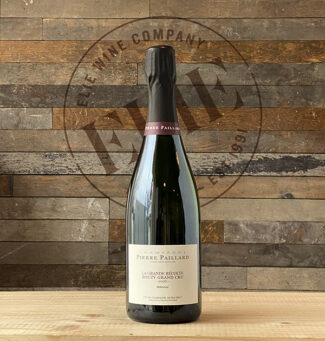 (Disgorgement: March 2021) 55% old vine Pinot Noir and 45% old vine Chardonnay from two sites on the south-facing slope of the mountain of Reims. The Pinot Noir comes ‘Les Maillerettes’ and the Chardonnay comes from ‘Les Mottelettes’ and represent the mother vines used for the massal selections made in-house at Champagne Pierre Paillard. Both vineyards are less than an acre in size, and the wine represents the quintessence of house style and terroir. A rare Champagne that may benefit from decanting, ‘La Grande Récolte’ is dosed at 1 gram per liter, and spent 8 years on lees before disgorgement. About 12,000 bottles made
(Disgorgement: March 2021) 55% old vine Pinot Noir and 45% old vine Chardonnay from two sites on the south-facing slope of the mountain of Reims. The Pinot Noir comes ‘Les Maillerettes’ and the Chardonnay comes from ‘Les Mottelettes’ and represent the mother vines used for the massal selections made in-house at Champagne Pierre Paillard. Both vineyards are less than an acre in size, and the wine represents the quintessence of house style and terroir. A rare Champagne that may benefit from decanting, ‘La Grande Récolte’ is dosed at 1 gram per liter, and spent 8 years on lees before disgorgement. About 12,000 bottles made
- - -
Posted on 2022.01.08 in Notebook: A’Boudt Town, France, Champagne
Featured Wines
- Notebook: A’Boudt Town
- Saturday Sips Wines
- Saturday Sips Review Club
- The Champagne Society
- Wine-Aid Packages
Wine Regions
Grape Varieties
Aglianico, Albarino, Albarín Blanco, Albarín Tinto, Albillo, Aleatico, Arbanne, Aubun, Barbarossa, barbera, Beaune, Biancu Gentile, bourboulenc, Cabernet Franc, Cabernet Sauvignon, Caino, Caladoc, Calvi, Carcajolu-Neru, Carignan, Chablis, Chardonnay, Chasselas, Clairette, Corvina, Cot, Counoise, Erbamat, Ferrol, Fiano, Frappato, Friulano, Fromenteau, Fumin, Garnacha, Gewurztraminer, Godello, Graciano, Grenache, Grolleau, Groppello, Juan Garcia, Lambrusco, Loureira, Macabeo, Macabou, Malvasia, Malvasia Nera, Marsanne, Marselan, Marzemino, Melon de Bourgogne, Merlot, Mondeuse, Montanaccia, Montepulciano, Morescola, Morescono, Moscatell, Muscadelle, Muscat, Natural, Nero d'Avola, Parellada, Patrimonio, Petit Meslier, Petit Verdot, Pineau d'Aunis, Pinot Auxerrois, Pinot Blanc, Pinot Gris, Pinot Meunier, Pinot Noir, Poulsard, Prieto Picudo, Rondinella, Rousanne, Roussanne, Sangiovese, Sauvignon Blanc, Savignin, Semillon, Souson, Sparkling, Sumoll, Sylvaner, Syrah, Tannat, Tempranillo, Trebbiano, Trebbiano Valtenesi, Treixadura, Trousseau, Ugni Blanc, vaccarèse, Verdicchio, Vermentino, Viognier, Viura, Xarel-loWines & Events by Date
- April 2024
- March 2024
- February 2024
- January 2024
- December 2023
- November 2023
- October 2023
- September 2023
- August 2023
- July 2023
- June 2023
- May 2023
- April 2023
- March 2023
- February 2023
- January 2023
- December 2022
- November 2022
- October 2022
- September 2022
- August 2022
- July 2022
- June 2022
- May 2022
- April 2022
- March 2022
- February 2022
- January 2022
- December 2021
- November 2021
- October 2021
- September 2021
- August 2021
- July 2021
- June 2021
- May 2021
- April 2021
- March 2021
- February 2021
- January 2021
- December 2020
- November 2020
- October 2020
- September 2020
- August 2020
- July 2020
- June 2020
- May 2020
- April 2020
- March 2020
- February 2020
- January 2020
- December 2019
- November 2019
- October 2019
- September 2019
- August 2019
- July 2019
- June 2019
- May 2019
- April 2019
- March 2019
- February 2019
- January 2019
- December 2018
- November 2018
- October 2018
- September 2018
- August 2018
- July 2018
- June 2018
- May 2018
- April 2018
- March 2018
- February 2018
- January 2018
- December 2017
- November 2017
- October 2017
- September 2017
- August 2017
- July 2017
- June 2017
- May 2017
- April 2017
- March 2017
- February 2017
- January 2017
- December 2016
- November 2016
- October 2016
- September 2016
- August 2016
- July 2016
- June 2016
- May 2016
- April 2016
- March 2016
- February 2016
- January 2016
- December 2015
- November 2015
- October 2015
- September 2015
- August 2015
- July 2015
- June 2015
- May 2015
- April 2015
- March 2015
- February 2015
- January 2015
- December 2014
- November 2014
- October 2014
- September 2014
- August 2014
- July 2014
- June 2014
- April 2014
- March 2014
- February 2014
- January 2014
- December 2013
- November 2013
- October 2013
- September 2013
- August 2013
- July 2013
- June 2013
- May 2013
- April 2013
- March 2013
- February 2013
- January 2013
- December 2012
- November 2012
- October 2012
- February 2004
Search



